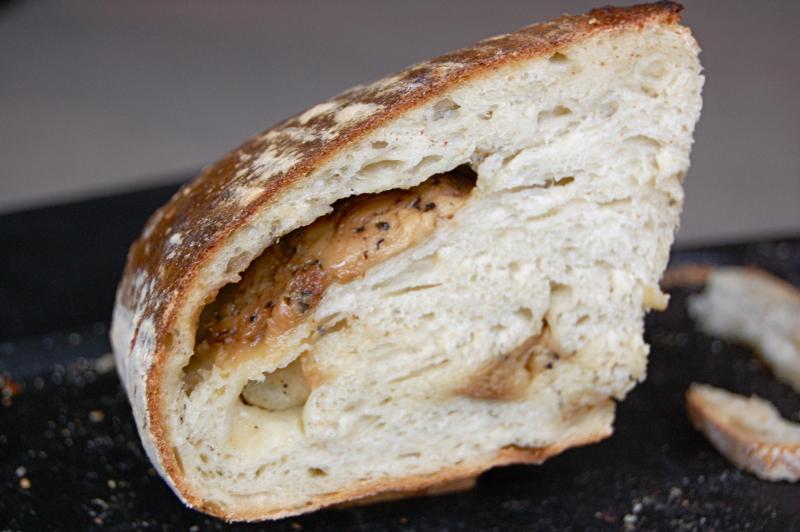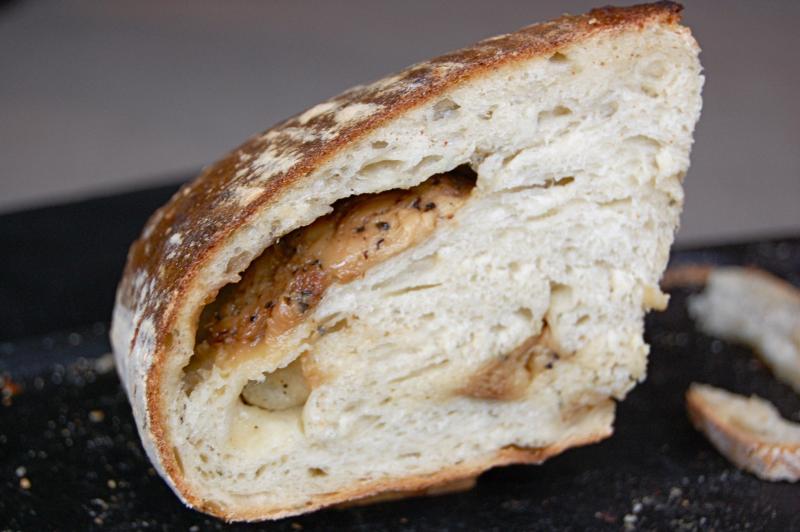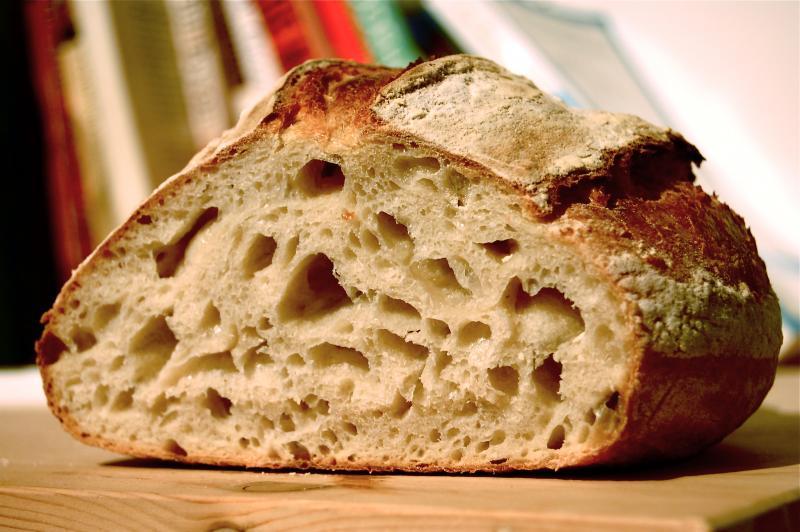
MikeJ
participating member-
Posts
80 -
Joined
-
Last visited
Content Type
Profiles
Forums
Store
Help Articles
Everything posted by MikeJ
-
I've baked a loaf of bread with 4 cloves of roasted garlic incorporated into the dough - pictures below, and see here for a full description.
-
Recently I made a sourdough loaf impregnated with 4 bulbs of roasted garlic. The procedure was as follows: roast 4 bulbs of garlic, olive oiled and in tinfoil, until dark and sweet. Refrigerate overnight, and the next day try to pop the cloves out of their skins whole. Then make some standard white sourdough - I usually follow something similar to the egullet sourdough recipe, this time with the addition of a couple tablespoons of very finely chopped rosemary. At the mixing stage, I also incorporated those garlic cloves that didn't make it out intact; maybe a bulb's worth. The garlic should be soft enough that it just blends into the dough. During bulk fermentation, I often use the stretch & fold technique. During the final stretch & fold (about 3 hours into the 4-hour bulk fermentation) I stretched the dough out like a pizza, scattered the rest of the roasted garlic over it along with some olive oil and pepper, and then folded it up, sealing all the garlic on the inside. An hour later I shaped the loaf and proofed as usual (for about 1.5 hours), then baked it. The result can only be described as an unmitigated success. The bread was redolent of garlic, and the roasted cloves popped up here and there like little treasures. The rosemary provided a measure of freshness. I think even more garlic could be incorporated without adverse effects - next time I will try six bulbs. Here are pictures:
-
Awesome looking bread, abooja.
-
This is a very interesting question. I've often noticed that a loaf of sourdough tastes noticeably more sour the day after baking, and sourer still the day after that, but I've never figured out why... surely all the acid-producing microorganisms are killed in the baking process, so there can't be acid being added to the bread. Presumably some process (oxidization?) is acting on the bread to bring out certain compounds and suppress others. I guess you could design an entire meal comprised entirely of foods that taste better the next day - boeuf bourguignon over thick slices of toasted sourdough, and for dessert maybe chocolate torte, which I have noticed also tastes better the next day.
-
Also, from a few weeks ago now: standard white sourdough (left), Hamelman's sourdough seed bread (right).
-
Standard white sourdough (10% rye) boule and, I guess, batard.
-
Thank you! That temperature sounds good, so I suppose it's down to the starter or the recipe. Don't be discouraged, I'm sure before long you'll be churning out sourdough loaves that will make you forget all about yeasted breads.
-
I've had exactly this phenomenon happen to me a few times, but I'm not sure if I can pin down the cause. My first thoughts would be that your starter wasn't active enough, or that the proofing temperature was either too high or too low. The other possibility that came to mind is that your starter might be contaminated. When you feed it, does it smell robust and yeasty? I find a contaminated starter often has has a slight "cheesey" smell. I'd recommend keeping the starter out and refreshing it a few times using a low ratio of old starter to new flour and water (1:10 or so). Keep it nice and warm, and when it's unquestionably active, try another recipe - jackal10's sourdough recipe has always worked well for me. Edit: good luck with baking the loaf you've got proofing... whenever I've baked these types of loaves what I end up with is a sort of dense fudge-y sourdough pancake, which is actually not as bad as it sounds.
-
This reminded me of a passage in Roald Dahhl's "Danny the Champion of the World," in which a friend of Danny's father brings him a pie: I would search for a recipe for something like chicken and gammon pie, and modify it to include whole boiled eggs and a phyllo top crust.
-
I, too, love food and being in shape about equally. I think the key is selective overindulgence. As far as I'm concerned, it's perfectly fine to eat bushels of the following delicious foods with impunity: asparagus, garlic (roasted with olive oil and smeared on something thin and crunchy, preferably), peppers, squash, leafy salads... I'll come back and add more if they occur to me. Everything else should be enjoyed in moderation. It's a little depressing when you read these fitness forums, and people post their eating regimes, meals from which tend to look like this: Lunch: 1.7 cups oats with water, 1 scoop protein powder, 1 can of tuna with hot sauce. When it's just as healthy and infinitely more delicious to have poached salmon with brown rice, broccoli and a little hollandaise. Which reminds me, those of us who exercise a lot and limit what we eat have an automatic advantage in enjoying food: hunger is the best sauce. Blanched vegetables with smoked salmon, minced garlic and a red wine vinegar/olive oil dressing tastes as good when you're habitually famished as fish and chips do when you're habitually satiated. At least, that's been my experience.
-
If you use commercial yeast in the starter it will leaven the bread too quickly for it to develop flavour, even if there are also bacteria in the culture. Some people say that the commercial yeast used to get the culture going is eventually replaced by wild yeast after repeated refreshings. I don't know if this is true and I don't see any obvious reason why it should be - but fortunately it's easy enough to make a starter without commercial yeast. Give that a try, it's very satisfying when you see the first indisputable bubbles!
-
Went out of town for the weekend, so on Thursday I made some dough using about a cup of preferment, 3 cups unbleached white flour, a cup of water and a couple tsp of salt (I should measure more accurately, but I usually just adjust the amounts of flour and water until the consistency feels right)... Anyways, I put the dough in the fridge for three and a half days, and took it out yesterday evening. It hadn't risen much and the gluten was a little weak from fermenting for so long, but I let it come up to room temp for a couple hours, folding every 30 mins, and then shaped it and let it rise for another 2 hours. The oven spring was surprisingly good for a dough that old, and the texture is lighter than I expected as well... lots of flavour, very rich and buttery, and the a great chewy crust. I suppose you'd call it sourdough a l'ancienne, or pain a l'ancienne au levain. Sorry about the washed out colour in the pic -
-
Jackal, I was thinking more of a handful of quinoa in the dough for flavour. I've seen quinoa flour at the supermarket and wanted to experiment with this, but haven't gotten around to it yet.
-
Very nice. Have you thought about milling some of it to use in that sourdough of yours?
-
In one of the Narnia books, C.S. Lewis describes the meat of carnivorous bears as vile and gamey, and the meat of bears that feed on fruits and berries as sweet and mild. I don't know if he ever ate bear, but from what I understand the former description is closer to the truth. Wonderful animals... whatever you decide to do with it, I hope at least that the meat doesn't go to waste.
-
I had probably my most successful sourdough attempt over the weekend. Used a very wet dough and ended up with my best crumb structure so far:
-
Heston Blumenthal bakes his on an inverted cast iron pan under the grill - an interesting idea that I've yet to try, but it looks like it works well.
-
I've made slkinsey's tomato/onion/butter sauce about 15 times since I read about in this thread. Seriously, seriously good. Sometimes I chop up some basil and throw it on at the end, but it's thoroughly satisfying all on its own.
-
But pastries, pan breads etc. tend to be higher on the GI, right?
-
The photos aren't showing up for me - anyone else having this problem? What temperature are you baking at?
-
Apparently toaster fires are one of the main risks of pop tarts. Dave Barry wrote an article exploring this to some extent.
-
Sometimes if I'm after a shatteringly crisp skin, I'll rub vegetable oil over the bird, throw some salt on, and then roast at a high-ish temperature (shortening the cooking time accordingly). This always seems to work - but I'm definitely no expert, compared to most people here.
-
That sounds phenomenal... I don't suppose you have a recipe handy? ← I definately do! Here you go: 2L 35% cream 1/2-2/3 Cup sugar depending on sweet you like it 20 egg yolks 2tsp vanilla extract 500gm white chocolate 4oz Grand Marnier Heat cream just until boiling, pour over chocolate and stir till melted Temper eggs with cream mixture add other ingredients, strain through chinois bake in convection oven @300 covered with a sheet pan approx. 30-40 min. depending on size of ramekin used They are done when they have that "shake"- they will finish setting up while you let them cool in the water bath on the counter Cool overnight in fridge Brulee them and enjoy! ← Finally got around to making these - I went easy on the sugar and used a little more Grand Marnier, and they turned out sublimely. Lots of great compliments from the family. I think when I make them next I might experiment with using a little orange zest, although that might compromise the velvety texture a little bit.
-
I am in awe of the things you people make. I can barely throw together flour, water and salt to make a loaf of bread.
-
Those are both phenomenal. Just amazing. The leaf cake really reminded me of something, and I couldn't figure out what it was until I saw the reference to Goldsworthy's black holes. Then it clicked. I think, if anything, I prefer yours to his.






